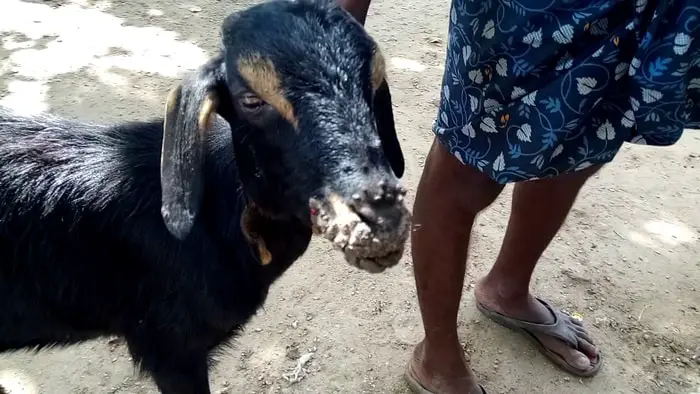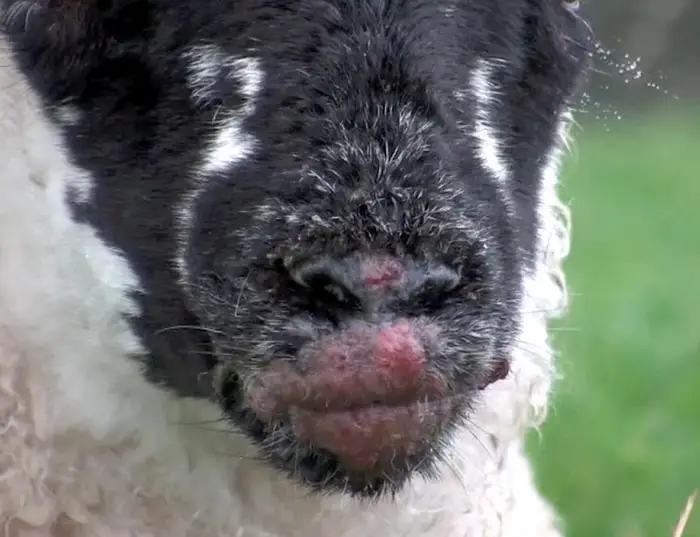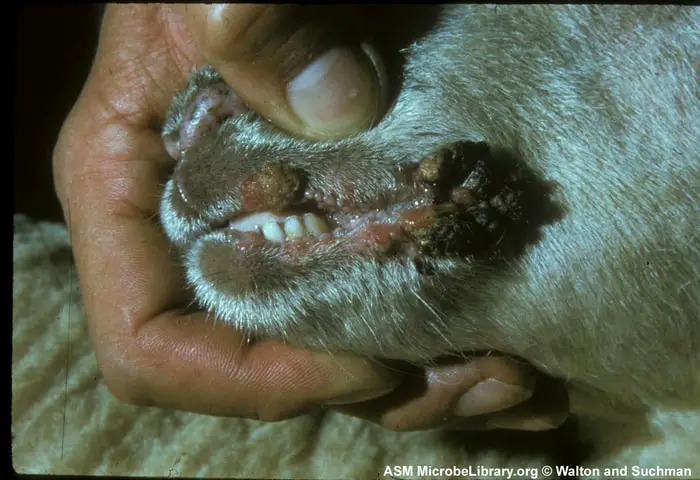Contagious Ecthyma in goats is a highly contagious viral disease that spread very rapidly. Pustular and scabby lesions characterize the disease on the muzzle, lips, and coronet with high morbidity. The disease is seen in primary goats than sheep. Contagious Ecthyma found worldwide. The disease is also called scabby mouth or sore mouth.
Epidemiology of Contagious Ecthyma
Contagious Ecthyma in goats is mainly seen in both rainy and dry seasons. The lambs and kids of 3-6 months of age are most commonly and severely affected. The morbidity rates of the disease vary from 70-80 %, with a case fatality rate of 5 to 15%. The recovered animals acquire solid immunity for 2-3 years. However, the newborn kids or lambs born from an immune mother remain susceptible to the disease indicating that antibodies are not passed to the colostrum. The disease is transmitted rapidly through contact with affected animals or contaminated inanimate objects. The injury to the skin around the mouth is essential for viral invasion. The disease also has zoonotic importance that transmits to persons directly involved with the handling of sheep and goats.

Causes of Contagious Ecthyma
The Contagious Ecthyma virus causes the disease under the genus Parapoxvirus belongs to the family Poxviridae. The virus has six immunological strains and is antigenically related to goat poxvirus but distinct from the vaccinia and sheep pox virus.
Pathogenesis of Contagious Ecthyma
The pathogenesis of the disease is:
- The virus gains entry through irritated skin and mucous membranes.
- The virus replicates and develops primary viremia, infecting the organs of primary affinity like lymphoreticular tissue, bone marrow, and liver.
- During the second viremic phage, symptoms of the disease appear on the head, extremities, udder, genitalia, lungs, and liver.
- The lesions begin as a pimple or macule resulting from the proliferation of epithelial cells of the Malpighian layers of the epidermis.
- The cells in the nodule soon undergo hydropic degeneration, swell, burst, and blister is formed.
- The vesicles are invaded with leukocytosis to form pustules, which rupture to form ulcers with scabs.
- The thick scabs or crusts then fall in 3-4 weeks, leaving no scar.
- The cause of the severe, sometimes fatal disease is virus replication in the internal organs, which simultaneously occurs with growth in the skin and mucous membranes.
- There are sometimes sub-clinical and latent forms of infection with virus excretion but without symptoms.
- Unapparant infections can be activated by stress that leads to immunosuppression.
Clinical Signs and Symptoms of Scabby Mouth
The usual clinical signs and symptoms of the disease are:
- The affected animals reveal scabby lesions that develop as papule and pustules stages after an incubation period of 2-3 days.
- First lesions usually start at oral commissures and then spread to lips, muzzle, and surrounding skin.
- Thick, tenacious brown scabs, as discrete or continuous plaques develop on oral commissures, mouth, and nostrils with the presence of eruptions.
- The lesions are painful, and animals are unable to eat or suckle their dams.
- Extension of the lesions in the buccal cavity and respiratory tract may cause gastroenteritis and pneumonia.
- Lesions may also develop on the coronet, ears, and around the anus, vulva, prepuce, or scrotum.
- Unusual distribution of lesions in goats on the head, chest, neck, and flanks has also been reported.
- The usual course of the disease is 2-4 weeks. However, the disease recovers within 3-6 weeks without treatment.

Pathological Lesions of Contagious Ecthyma in Goats
The pathological signs of scabby mouth in goats are:
- The lesions are usually confined to mouthparts or areas of skin.
- There may be ulcerative stomatitis, omasitis, reticulitis, enteritis, and necrotic lesions in the lungs with pleuritis or necrotic foci in the liver in cases with secondary infection.
- Virus multiplication leads through a proliferative phase to ballooning degeneration with pustule formation and subsequent cell lysis.
- Cytoplasmic inclusion bodies occur in the affected cells and nuclear changes, which become visible as fine intranuclear filaments approximately 36 hours post-infection.
Diagnosis Procedure of Contagious Ecthyma
The diagnostic procedures of sore mouth in goats are:
- The disease can be diagnosed by history and clinical signs.
- Confirmatory diagnosis by isolation of virus and electron microscopy.
- Serological tests like Gel Diffusion, Immunofluorescence, Immunoperoxidase, and ELISA help confirm the disease.

Differential Diagnosis of Scabby Mouth in Goats
The malignant form of the disease should be differentiated from:
- Goat Pox or Sheep pox infection.
- Blue Tongue.
- Ulcerative dermatosis.
- Mange.
- Mycotic dermatitis.
Treatment of Sore Mouth in Goats
There is no specific treatment for the disease, but the management of the disease is:
- Apply emollient, antiseptic creams like penicillin ointment or 2% salicylic acid ointment.
- Lotions like 5% copper sulfate, iodine, or triple dye solutions are beneficial.
- Broad-spectrum antibiotics may be given when a secondary bacterial infection is suspected.
Prevention and Control of Contagious Ecthyma
The preventive measures that you can follow on your farm are:
- During an outbreak, strict hygiene and sanitary measures, including cleaning of premises and isolation of affected animals, should be adopted.
- The disease may be controlled by using tissue culture vaccines.